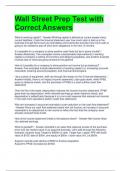Exam (elaborations)
Wall Street Prep Test with Correct Answers
- Course
- Institution
Wall Street Prep Test with Correct Answers What is working capital? - Answer-Working capital is defined as current assets minus current liabilities; it tells the financial statement user how much cash is tied up in the business through items such as receivables and inventories and also how much ...
[Show more]



